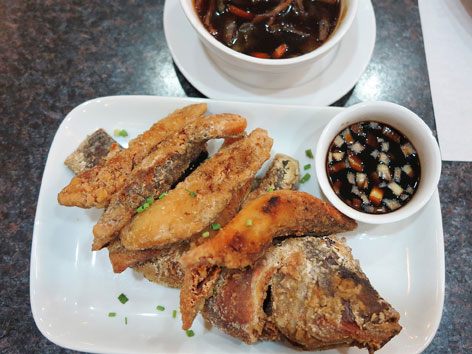Ethiopian Chicken Stew (Doro Wett)
Ethiopia
amantour
guides you to the best local dishes & drinks in
125+ cities. See map now



.jpg) Going somewhere and wish you could take all of a city’s Eat Your World info with you? With EYW’s Kindle and City Guides, you can! Don’t miss out on any local foods or drinks during your next trip.
Going somewhere and wish you could take all of a city’s Eat Your World info with you? With EYW’s Kindle and City Guides, you can! Don’t miss out on any local foods or drinks during your next trip.
EYW wants your food photos!

EYW wants your food stories!
Hey guys I am a traveler who loves to explore different places around the world. I often visit outside of Canada, So whenever I have to travel around the world I always book my flight tickets from the... Read more

What: Fried fish, pritong isda (“pree-tong ees-da”), is a staple that harks back to Manila’s early fishing roots. The name comes from frito (or prito in Tagalog, which has no letter F), the Spanish word for “fried.” While we don’t know what people called their fried fish before the Spanish came, we do know that the preference here is for fish that’s fried whole, bones and all. Virtually any type and size of fish is fair game, from tiny anchovies to platter-size grouper—if it’s too big to fry whole, it will just get chopped up. The fish is usually sprinkled or rubbed liberally with salt before being fried in oil—typically coconut oil—but that’s where the seasoning ends. The secret to good pritong isda lies not only in the freshness of the catch, but also in the sawsawan (“sahw-sah-wan”), or dipping sauce. It might be as simple as patis, fermented fish sauce, or patis with kalamansi; toyo, which is soy sauce; toyomansi, a mix of toyo and kalamansi; suka, vinegar; or many more.
Good to know: If you wish to sample from Manila’s local bounty of fish, ask for galunggong (“gah-loong-gong,” which is scad, considered the everyman’s fish), hito (“hee-toh,” catfish), bangus (“bah-ngoos,” milkfish), or lapu-lapu (“lah-poo-lah-poo,” red grouper)—the latter, topped with a sweet-sour sauce, is particularly beloved by the Filipino-Chinese community. Also, keep in mind that sometimes isda, the generic word for fish, is replaced by the type of fish, so you might see pritong tilapia or pritong lapu-lapu on menus.
Where: Truth be told, you can find decent fried fish anywhere, from the lowliest carinderia (local eatery) serving galunggong to the poshest Chinese restaurant. We like a place somewhere in the middle: With several branches across metro Manila, Recipes (632-772-2216; multiple locations including Corte de las Palmas, 2nd floor, Alabang Town Center, Muntinlupa City, Taguig, map) is a modern cafe renowned for reliable, good-quality food, and its pritong isda is no exception.
When: Mon-Fri, 11am-9pm; Sat & Sun, 10am-10pm. No real queues, but expect to wait to be seated during the lunch and dinner rush.
Order: Pictured is fried tilapia (Php 225), served with a choice of dipping sauces; we ordered one with tamarind sauce (smaller bowl) and another with escabeche, a tomato-based sauce. Most of the fleshy bits were already cut away from the fish’s bone, helping us tackle the meat quickly and easily. Impressively, it was not greasy at all, and its delicate flour-based batter gave it some extra crunch. The fish, so mild on its own, was lightly salted to bring out its flavor; as usual, the truly interesting notes came from the sauces—a slightly sweet, fruity tang from the tamarind and a more traditional, stewed-tomatoes type of flavor from the escabeche. We also ordered the tasty bagoong (fermented shrimp paste) fried rice with pork and a serving of dinuguan (pig’s blood stew; see entry).
Alternatively: We love the savory, satisfying pritong bangus (fried milkfish) at The Carriedo at Elias (Bonifacio High St., map). A whole milkfish is butterflied, marinated in vinegar, dipped in flour, deep-fried, and then covered in chopped garlic. Yum!
Good to know: Think you might get stuck with a fish bone? Ask any restaurant serving pritong isda if it has boneless bangus, which is growing more common.
©2025 Eat Your World, LLC - All Rights Reserved